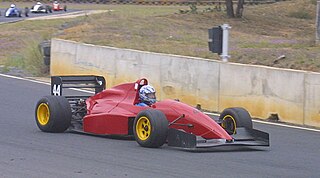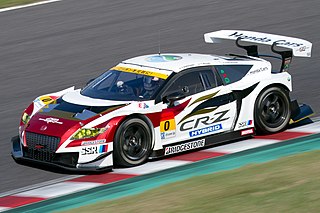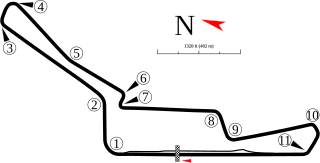
The Formula 3000 International Championship was a motor racing series created by the Fédération Internationale de l'Automobile (FIA) in 1985 to become the final preparatory step for drivers hoping to enter Formula One. Formula Two had become too expensive, and was dominated by works-run cars with factory engines; the hope was that Formula 3000 would offer quicker, cheaper, more open racing. The series began as an open specification, then tyres were standardized from 1986 onwards, followed by engines and chassis in 1996. The series ran annually until 2004, and was replaced in 2005 by the GP2 Series.
Lola Cars International Ltd. was a British race car engineering company in operation from 1958 to 2012. The company was founded by Eric Broadley in Bromley, England, before moving to new premises in Slough, Buckinghamshire and finally Huntingdon, Cambridgeshire, and endured for more than fifty years to become one of the oldest and largest manufacturers of racing cars in the world. Lola Cars started by building small front-engined sports cars, and branched out into Formula Junior cars before diversifying into a wider range of sporting vehicles.
The Japanese Super Formula Championship is a formula racing series held primarily in Japan. It is considered to be the pinnacle of single-seater racing in Japan or Asia as a whole, making it one of the top motorsport series in the region. The series is sanctioned by the Japan Automobile Federation (JAF) and managed by Japan Race Promotion (JRP). As of 2024, Super Formula is the second fastest racing series in the world, after Formula One.

Ivan Franco Capelli is an Italian former Formula One driver. He participated in 98 Grands Prix, debuting on 6 October 1985. He achieved three podiums, and scored a total of 31 championship points. From 1998 until 2017, he was a Formula One commentator on the Italian TV station Rai 1.

Formula Holden was an Australian open wheel racing category introduced in 1989.

M-TEC Company, Ltd., doing business as Mugen Motorsports (無限), is a Japanese company formed in 1973 by Hirotoshi Honda, the son of Honda Motor Company founder Soichiro Honda, and Masao Kimura. Mugen, meaning "without limit", "unlimited" or "vast", is an engine tuner and parts manufacturer that manufactures OEM parts such as body kits and sports exhausts for Honda. Despite the family relationship, Mugen is not, and has never been, owned by Honda Motor Company; however, Mugen owner Hirotoshi Honda has been the biggest shareholder in Honda since his father's death in 1991.

Judd is a brand of racing car engines built by Engine Developments Ltd., a company founded in 1971 by John Judd and Jack Brabham in Rugby, Warwickshire, England. Engine Developments was intended to build engines for Brabham's racing efforts, and became one of the first firms authorised by Cosworth to maintain and rebuild its DFV engines, but has since expanded into various areas of motorsport.
The 1993 FIA Formula 3000 International Championship was a motor racing series for Formula 3000 cars. Contested over nine races, it was the ninth FIA Formula 3000 International Championship.

The 1993 Indonesian Grand Prix was a Formula Brabham race held on August 21–22, 1993 at the Sentul International Circuit near Citeureup, Indonesia. It was the first round of a two event Pan-Pacific series for the Australian-based Formula Brabham category.

Équipe Ligier is a motorsport team, best known for its Formula One team that operated from 1976 to 1996. The team was founded in 1968 by former French rugby union player Guy Ligier as a sports car manufacturer.

The DAMS GD-01 was an unraced Formula One car used by the French motorsport team, Driot-Arnoux Motor Sport (DAMS). The GD-01 was designed and built by a collaboration of DAMS and Reynard engineers from 1994 to 1995, and was intended to establish the team—which had achieved considerable success in lower categories—in Formula One (F1), the premier Fédération Internationale de l'Automobile (FIA)-sanctioned level of racing. However, due to insufficient financial backing, the team never entered the championship, despite completing construction of the chassis and conducting limited testing.

Reynard Motorsport was the world's largest racing car manufacturer in the 1980s. Initially based at Bicester and latterly at Reynard Park, Brackley, England the company built successful cars in Formula Ford 1600, Formula Ford 2000, Formula Vauxhall Lotus, Formula Three, Formula 3000 and CART.
Leyton House Racing was a Formula One constructor that raced in the 1990 and 1991 seasons.
The 1989 British Formula 3000 Championship was the first season of the British Formula 3000 Championship. Australia’s Gary Brabham took the inaugural title, racing an ex-Jean Alesi Reynard-Cosworth 88D for Bromley Motorsport. He took three race wins during the season. Brabham, son of three time World Drivers Champion, Jack Brabham, only raced in the series after a deal to race for Roni Q8 Racing in the International F3000 series fell through.
The 5th round of the inaugural British Formula 3000 Championship, saw the series arrive back in Kent, for their second visit of the year to Brands Hatch, on 25 June.

The Reynard 92D is an open-wheel formula race car, designed and developed by Malcolm Oastler, and constructed and built by Reynard Motorsport, for use in Formula 3000 categories, Formula Nippon and Formula Holden racing series, in 1992.

The Lola T96/50 is an open-wheel formula race car chassis developed by British manufacturer Lola, for use in the International Formula 3000 series, a feeder-series for Formula One, between 1996 and 1998, until it was replaced by the new Lola B99/50 chassis for the new in 1998. Similar chassis', dubbed the Lola T96/51 and Lola T96/52, were used in the Japanese Formula Nippon series until 1999, and were powered by 3.0 L (180 cu in) Mugen V8 engines.
The Mugen MF308 is a naturally aspirated, petrol-powered, 3.0 L (180 cu in), V8 racing engine, designed, developed, and built by Mugen Motorsports, for Formula 3000 racing categories, between 1988 and 2005. It produced between 490–500 hp (370–370 kW) over its lifetime. It famously powered Jean Alesi to the 1989 International Formula 3000 Championship, with Eddie Jordan Racing.
The Reynard 88D is an open-wheel Formula 3000 car, designed and developed by Malcolm Oastler, and constructed and built by British manufacturer Reynard Motorsport, for both the 1988 International Formula 3000 Championship, and the 1988 Japanese Formula 3000 Championship, as well as the 1989 British Formula 3000 Championship.
The Mooncraft Special MCS 9, also known as the Reynard 89DGC, was a Japanese sports prototype race car, used in the Fuji Grand Champion Series, between 1988 and 1989. Based on either the Reynard 89D, or the Lola T88/50 Formula 3000 cars, it was powered by a 3.0 L (180 cu in) Mugen MF308 V8 engine, and ran on either Bridgestone or Dunlop tires.










